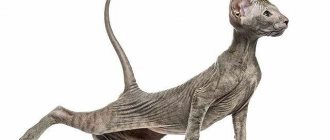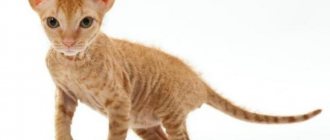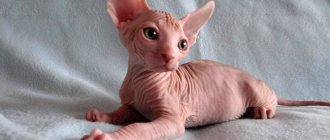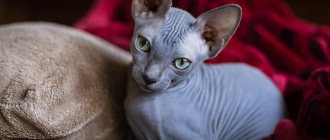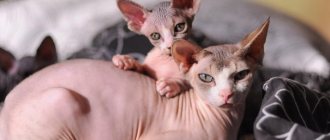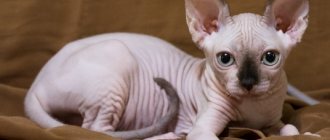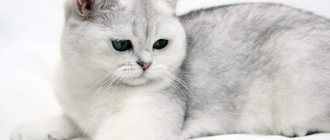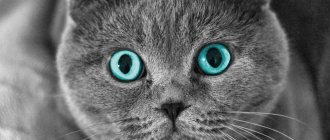History of the origin of the breed
This cat is of Russian origin. Its first representatives appeared in St. Petersburg, bred by felinologists Olga Mironova and Tatyana Komarova by crossing two well-known lines - the Don Sphynx and the Oriental.
The ancestor of the St. Petersburg Scythians is the oriental female Radma Von Jagenhorff, the father is the male Don Sphynx Afinogenes Myth. In the first two litters we managed to get four original kittens - Mandarin, Muscat, Nezhenka, Nocturne.
The breed owes its lack of hair to the Scythian, the shape of the head and body, as well as the Asian character - the Oriental.
Bald Pepper literally translates to “bald Peter.” This name arose thanks to the humorous name of one of the statues of Peter the Great in the northern capital, where the ruler is depicted with his head not covered with a wig.
The Neva Sphinx was immediately accepted by international felinology. In 1996 it was registered with the Breeding Feline Federation (SFF), in 1997 - with The International Cat Association (TICA), in 2003 with the World Cat Federation (WCF).
Breed standard
According to the TICA system classification, the Peterbald has the following description:
- Head. Triangular in shape, large in relation to the body, long, with flat cheekbones and a pointed chin. Two planes - a straight nose and a flat forehead.
- Nose. Long, straight and wide, with a “proud, eagle-like profile.”
- Mustache and eyebrows. Absent or thin, curly, broken.
- Neck. Long, graceful, narrow.
- Ears. Very large, widely spaced, protruding beyond the cheek line. With a wide base and sharp tips.
- Eyes. Medium size, round, slightly elongated. Normal convexity. Quite widely spaced - the distance between them is equal to the width of one eye. Eye color can be deep blue, bright blue, green, regardless of the pattern and shade of the skin.
- Body. Long, graceful, muscular, lean, the width of the body is the same along the entire length from the shoulders to the hips.
- Paws. Medium length, muscular, dry, slender. The hind ones are slightly longer than the front ones. The foot is elongated with rounded pads and toes.
- Tail. Muscular, agile, proportional to the body.
- Dimensions. Small ones. The female weighs about three, the male no more than four kilograms.
- Color. The skin is mobile, elastic, with folds, soft and velvety to the touch. The textures of the coat are varied, which is unique to this breed - from completely bald individuals to completely covered with hair. Acceptable colors are color point, blue, lilac, chocolate, particolor, cream.
- Crossbreeding. Allowed with Don Sphynx, Oriental and Siamese breeds.
Flaws:
- break (bend) on the bridge of the nose;
- structural defects of the skull and muzzle;
- small, weak chin;
- heavy, round body;
- severe curvature of the front paws.
Disqualification:
- defects, tail breaks;
- keel-shaped protruding chest;
- strabismus;
- aggressive behavior;
- traces of artificial hair removal.
Coat Variations
Only the Peterbald has such a variety of skin and coat varieties. In one litter, kittens of absolutely all types can be born:
- Brush. They are born with little fur. As they grow older, the fur disappears in some areas, while the rest are evenly covered with hair.
- Brush point. At birth, the kitten is covered with thicker hair, the muzzle and tail are completely pubescent. In an adult animal, fur remains on some parts of the head, paws and tail. The rest of the body is covered with a delicate short flock.
- Velours. At birth, a kitten has long hair on its face, paws, and tail. Later, very short hair remains in these areas, the rest of the body is naked.
- Flock. The newborn has no eyebrows or mustache. Light fur all over the body can be determined only by touch, not visually visible, the hair length is up to two millimeters. An adult cat is completely hairless; there may be some sensation of fur on the hands.
- Straight-haired. Full coat, characteristic of the Oriental, there is no hairless gene. In terms of body structure and habits - Peterbald.
- Rubber (bald-born). It is very rare that babies are born completely bald, both visually and to the touch. In an adult cat by the age of two, the skin feels like rubber, stretches well, the skin is velvety and soft to the touch.
It is not always possible to determine the type of integument immediately at birth. More often this can be done in five to seven days.
The type indicator can be the period of eye opening. The Peterbald has a special structure of the lacrimal glands, which allows rubber sphinxes to be born with open eyes without the threat of loss of vision. Brush, point brush and velor open their eyes on the fifth day after birth.
The most valued and recommended for show class are bald and flock-Peterbalds, as they are animals with the most pronounced characteristics of the breed.
| The photo shows the litter of a brash cat. The different types of kitten fur are clearly visible. Brown marbled kitten is a brush. The red and brown marbled kitten is a brush or brush-point, with thick hair on the paws and short hair on the body clearly visible. Another brown flocked kitten and a hairless kitten. |
The first St. Petersburg sphinxes of the author's line - Muscat and Mandarin - had short millimeter hair, which almost disappeared by the age of one year. Their type of hair growth was subsequently called “flock” because the fur remaining on the body resembled flock upholstery fabric. Heterozygous St. Petersburg Sphynxes have a very different coat: from the lightest velvet coating without whiskers and eyebrows, to velor - short fur on the body and longer on the tail and paws, of varying thickness. It is very difficult to predict how velor cats will undress by the age of two. They can shed their hair completely, or they can become completely hairless on the body, but with residual hair on the paws, face and tail (brush points - that is, the hair will remain on the points: paws, tail, muzzle)
Starting from the second generation, from heterozygous St. Petersburg Sphynxes (that is, carrying the gene for normal hair), kittens began to be born that were completely naked to the touch. Under the hand, their skin no longer felt velvety, but stretched like rubber. Such bare-born Peterbald kittens (homozygous for the dominant gene), that is, without the gene for normal hair in their genotype, turned out to be quite problematic for unprepared breeders. With a delayed type of development in the first weeks of life, they require maximum human participation in their cultivation. They feel best with long-term natural feeding with early supplementary feeding and constant heating. If in an average litter of five St. Petersburg Sphynx kittens one is born with wool or brush (brush - hard, crimped hair), two are heterozygous “flock” or “velor”, and two are homozygous bare-born, then most often these babies have little chance of surviving without 24/7 assistance from the breeder. This can be explained by the fact that at birth, naked kittens are much smaller than their clothed counterparts, and cannot always independently make their way to the mother’s nipples. Therefore, a competent breeder must take on the function of a second mother in a timely manner and feed such babies along with the mother cat, constantly monitoring their condition. Cooling such kittens is also very dangerous, since their skin in infancy cannot protect them from changes in external temperature. However, hairless St. Petersburg Sphynx kittens, having successfully lived the first month of life, become active, viable and catch up in development with their furry counterparts. Unlike bareborns, “velor” and “brush” Peterbald kittens immediately from birth are distinguished by high vitality, early adaptability and, as a rule, do not cause additional troubles for breeders.
The hairlessness gene affects not only the hair, but also the whiskers (that is, mustaches and eyebrows) - in heterozygous St. Petersburg sphinxes they are highly curled, and from the first minutes after birth it is possible to determine the carrier of the hairlessness gene (this is especially important, since sphinxes can Straight-haired kittens will also be born that do not carry the hairless gene). In homozygous St. Petersburg Sphynxes, the whiskers are either absent or very thin and broken off.
Currently, breeders involved in breeding Russian Sphynxes have begun to lean towards the idea of a multiplicity of genes influencing the manifestation of hairlessness. In all likelihood, we should talk about the conditional (or incomplete) dominance of the hairlessness gene together with the action of a number of modifier genes. And this is perhaps one of the main secrets of the mysterious Russian sphinxes! If we were to propose that the hairlessness of St. Petersburg Sphynxes is due to one dominant gene, then when crossing hairless individuals and cats with normal hair, kittens of only two types should be born - hairless and with normal straight hair. However, as practice shows, this does not happen. Kittens are born of completely different types of coat: kittens with normal hair, with curled “Rex” hair, “velor” or “flock”, completely hairless. In turn, kittens born with “Rex” hair can also be divided into several types according to their coat: those that undress completely or partially with age, kittens that do not undress with areas of partial baldness with “Rex” hair and those with soft wavy hair. It would be difficult to explain such diversity in coat types by the presence of only two genes responsible for the formation of coat. Apparently, it is necessary to consider the Russian hairlessness gene Hr as conditionally dominant in relation to the hr gene (presence of hair). It is logical to assume that there are a number of gene modifiers of the hairlessness gene, under the influence of which the effect of the Hr gene is either enhanced or weakened. From this point of view, everything falls into place, and it becomes clear where such diversity in the type of coat of sphinxes comes from and why two hairless (not naked, but undressed with age) cats can give birth to both brushed kittens and kittens with ordinary wool, and why real naked sphinxes are born extremely rarely. And, most importantly, this theory can provide clues to how naked children can be born from two brush parents.
Written with the participation of materials from an article by Alena Isaeva. Kennel "Good Troll"
The photo shows several types of Peterbald coat
| 1. The Brush kitten has soft or hard, crimped fur all over its body. more than 5 mm long. The same Peterbald at the age of 1 year has partial hair loss along the body. |
| 2. A velor kitten has short velvet hairs on the body and short dense hair on the paws (probably complete baldness, small “socks” on the paws are possible) The same cat at the age of 1 year - the cat’s hair is preserved only on the paws - “socks”, the tip muzzles and single hairs on the tail. |
| 5. A flock kitten has no hair, only hair follicles that “support” the kitten’s color, the so-called “spraying”. The same cat is completely naked in one year. |
| 6. The kitten is naked, “rubber”, homozygous. |
What do the definitions mean:
BRUSH—
the kitten is covered with hair: short or long, soft or hard, crimped completely or partially. An adult animal either remains the same, or areas of partial baldness appear on the back and neck.
BRUSH POINT
the kitten is practically no different from the brush; it may have shorter hair on the back and head, and the tail is pubescent. An adult animal has thick hair only on the face, paws and, possibly, on the front, that is, on the “points”. The body is completely exposed or covered with thin flock.
VELOURS
— the kitten has short hair all over its body, longer and thicker on its paws and tail. An adult animal may have short residual hair on its paws and face, may undress almost completely, remaining in socks or socks, and extremely rarely undresses completely, but such cases are no exception. Hard wool comes off more easily than soft wool.
FLOCK
- the kitten, unlike the three previous types, has “humanoid” features of the muzzle and increased folding, that is, it has a type close to a hairless animal. As a rule, it has no eyebrows or mustache, or short mustache stubs. Wool, if you can call it that, is no more than 2 mm throughout the entire body. In appearance, the kitten does not seem to have it, but to the touch it is silky, very pleasant, like good velvet. It is simply impossible to confuse such a kitten with an epilated one (which happens with unscrupulous breeders who try to raise the price of a kitten in this way).
And there are many more transitional types of coat; sometimes it is difficult to guess what a kitten will become as an adult.
Photos and comments by Anna Panina.
Copying materials without permission from the site owner is prohibited.
Temperament of the St. Petersburg Sphynx
For those people who are thinking about purchasing a Neva Sphynx, it would be useful to understand the features of this breed:
- Experts often call this animal a “cat-dog”, since its habits are more reminiscent of a dog’s - they follow their owner with their “tail”, are able to learn the simplest commands, are smart and amenable to training.
- They are loving towards all family members and do not tolerate loneliness well.
- They are affectionate, capable of waiting for the owner all day, sitting at the door and joyfully rushing towards him. They know their name well and respond.
- Talkative too much. If you love a calm, measured life, then it is unlikely to be possible with the St. Petersburg Sphynx. The cat almost always “talks”, expressing all his feelings and emotions.
- Since the Peterbald cannot be left alone at all, you will have to find him a playmate, and he will get along with absolutely any pet.
- They are very playful all their lives and are happy to join children in noisy fun.
- Smart and cunning. They easily learn to open everything - bags, drawers, doors to the room, and even the refrigerator.
- They are unusually voracious, which is due to their physiological characteristics.
- Clean, excellent hunters.
When choosing this pet, you need to remember that you won’t be bored with it and balance your habits and inclinations with the cat’s temperament.
Characteristics of Peterbalds
The most important thing that Peterbald cats require is around-the-clock attention. They are terribly sociable and talkative. St. Petersburg sphinxes have a hard time experiencing loneliness, so they are ready to follow a person’s heels both day and night. At the same time, they meow loudly, and their voice is loud and harsh.
If such a bald miracle lives at home, then the owner will hardly be able to be alone with himself. Therefore, those who decide to get a chatty cat are advised to think carefully about their readiness for continuous contact with the pet. What should a person do who, despite being busy, wants to be friends with a cat? There are two options: either choose a representative of a different breed, or get another pet.
The Peterbald Sphynx is very active and playful. If you take him out for a walk wearing a collar, there will almost certainly be passers-by who will mistake him for a dog. A cat of this breed does not sit still; the world around him completely captivates this inquisitive person. He is constantly sniffing, exploring, trying something.
In addition, St. Petersburg felines are distinguished by their natural ingenuity and intelligence. It will not be difficult for the owner to teach his pet commands. For example, the St. Petersburg Sphynx may begin to bring small thrown objects.
These bald fidgets are crazy about small soft toys and ringing and rattling objects, which they fiddle with for hours. However, they can hardly be called serious hunters. Therefore, if the family already has small pets (birds, fish, hamsters, etc.), you don’t have to worry about their fate.
Peterbalds usually friendly towards all living creatures, without exception. They have a highly developed maternal instinct, for this reason Sphynxes are most likely to take care of weaker animals. St. Petersburg cats are also patient with children, but, in extreme cases, excessive importunity can be stopped with a decisive wave of a clawed paw.
Care and nutrition
The Neva Sphynx has no hair, but caring for your pet's skin is no less important. The skin of the animal secretes a special secretion, the role of which is to lubricate the folds and prevent drying and peeling. Bathing with zoo shampoo is necessary at least twice a week. After water procedures, you should dry your skin well to prevent hypothermia.
Like any cat, representatives of this breed love to bask in the sun. You need to carefully monitor their health to avoid burns and overheating.
In adult cats, the lacrimal glands continue to work intensively, so enhanced daily eye care is required using special lotions and herbal decoctions.
Ears, like those of any cat, are recommended to be cleaned at least once a week.
Nails should be trimmed to prevent accidental injury to the skin by unprotected fur during play.
St. Petersburg sphinxes need increased nutrition due to the high energy consumption to maintain heat exchange, which is also associated with the lack of hair in these animals. It is necessary to choose a complete and balanced diet - ready-made premium or super-premium dry mixtures, wet food or high-quality natural food.
How to care for the Neva "sissy"
It is obvious that Peterbalds, due to their physiological characteristics, require more careful care than ordinary cats. Below is a list of mandatory procedures for the St. Petersburg Sphynx:
- Daily cleansing of the skin around the eyes and eyelids
. Due to the lack of whiskers, lacrimation has become the norm for this breed.
- Ear cleaning and bathing once a week
. Since Peterbalds have virtually no fur, they sweat and get dirty a lot. In between water procedures, they should be wiped with a damp sponge. The choice of care products for the sensitive skin of your Peterbald should be approached responsibly. For bathing finicky Sphynxes, baby, hypoallergenic soap or special cat shampoo is suitable.
- Nail trimming several times a month
. Buying a scratching post will allow you to carry out this procedure less often. In addition, the process of self-manicure improves the cat’s mood. And a happy pet is a healthy pet.
Health
This breed has a genetic predisposition to only one disease - ectodermal dysplasia, which can lead to the formation of malocclusion.
Due to increased nutrition, a cat may develop obesity. You should monitor your pet's eating habits, avoiding starvation and overeating. An adult Sphynx needs to be fed at least twice a day, a kitten - up to five times.
These animals are also prone to colds. You should not allow them to become hypothermic, maintain a sufficient temperature in the premises and ensure there are no drafts. During the cold season, special clothing for cats is allowed.
Increased lacrimation requires special attention to your cat's eyes.
Timely deworming and annual vaccination against all known viral infections and rabies will also help maintain normal cat health.
With proper care, the life expectancy of a Peterbald can be twenty years.
What diseases do Peterbald Sphynxes suffer from?
On average, Peterbalds live 13-15 years.
But the St. Petersburg Sphynx is a representative of an exotic breed, and therefore is susceptible to several genetic diseases:
- The most dangerous disease is congenital underdevelopment of the thymus gland. The organ is responsible for immune defense and development of the body as a whole. Because of this disease, pets die while still kittens.
- Some blue and tortoiseshell Sphynx cats suffer from gum hyperplasia (tissue growth).
Peterbalds are characterized by sensitive skin diseases. In summer, veterinarians advise using sunscreen. And for dryness, use baby oil.
Kitten price
It is necessary to purchase a kitten only from professional nurseries at least three months old. A veterinary passport is required. Today, the sale of the St. Petersburg Sphynx is carried out by numerous breeders from different cities of Russia.
The cost of an animal varies widely depending on the purpose of purchase. You can buy a Neva Sphynx as a pet for ten thousand rubles. The price of a pet for professional breeding or exhibition work will be significantly higher.
Photo gallery of Peterbald and some other types of sphinxes:
1111
Conclusions about the Peterbald breed
global $ads_google;
//data-ad-slot=”2475549904″ $ads_google = empty($ads_google) ? false : true; ?> if ($ads_google == false) {?> $ads_google = true; ?> } ?> Before getting a St. Petersburg Sphynx, it’s worth weighing the pros and cons:
- Peterbalds are social animals and loyal companions. However, cats’ strong dependence on human communication can become a burden.
- Sphinxes are energetic mischief-makers, but they will never allow themselves to do too much. Their unearthly metabolism and activity have become the reason cats love to eat a lot and deliciously.
- The appearance of the St. Petersburg cat representatives is spectacular and unique, but it requires special care. They need to be taken care of like little children - monitor the condition of their skin and protect them from drafts.
- Peterbald cats are smart and inquisitive. Some breeders say that hairless cats, due to their character, can replace a dog.
Usually the oriental pet becomes everyone's favorite and a good friend for children and other animals.
